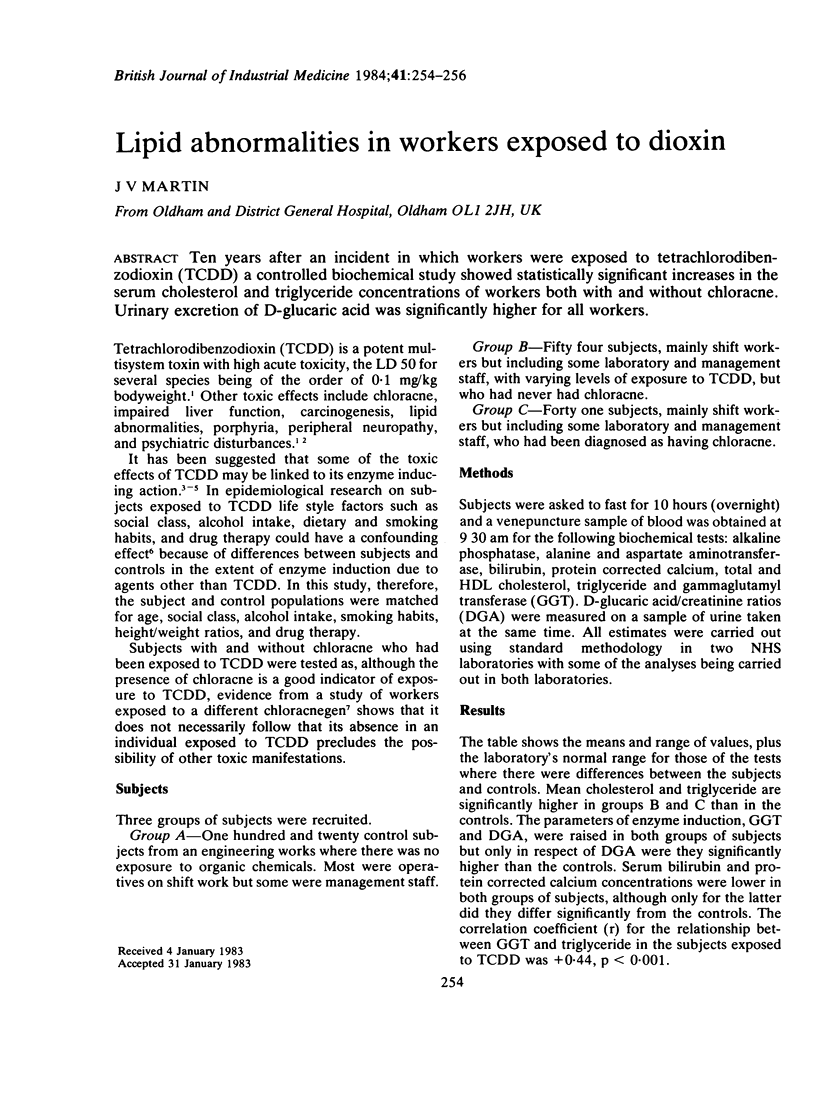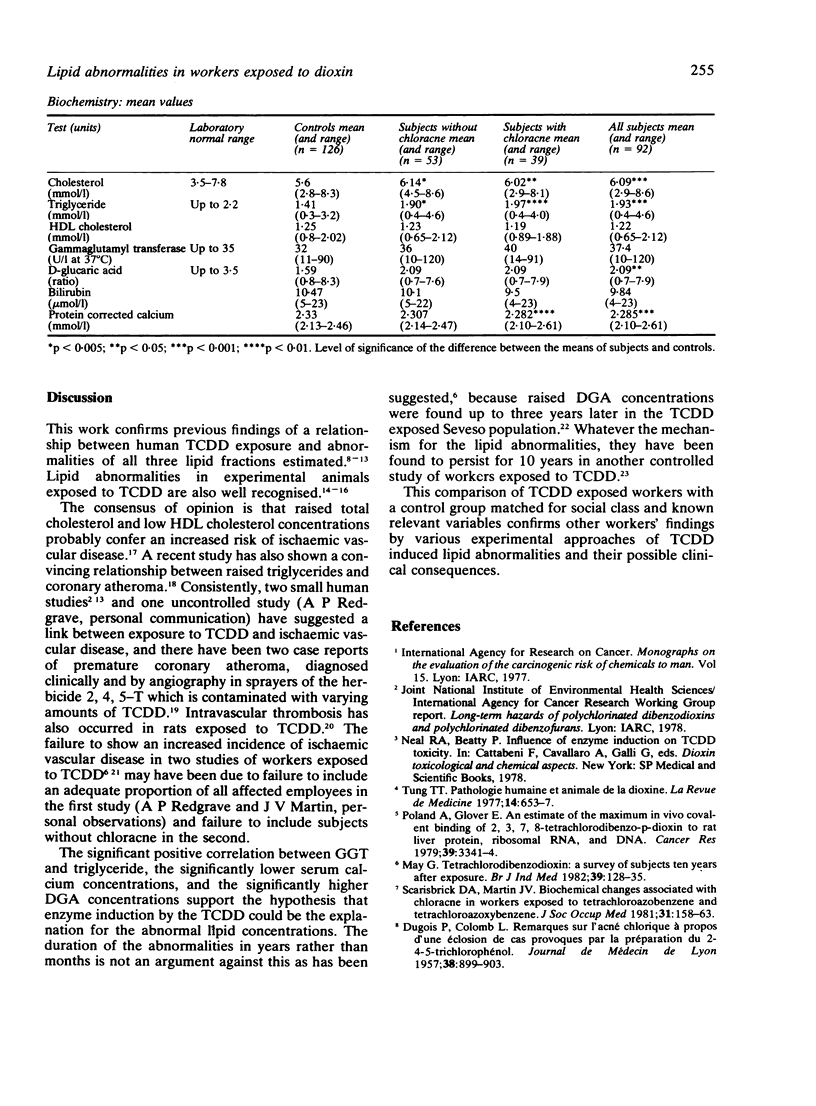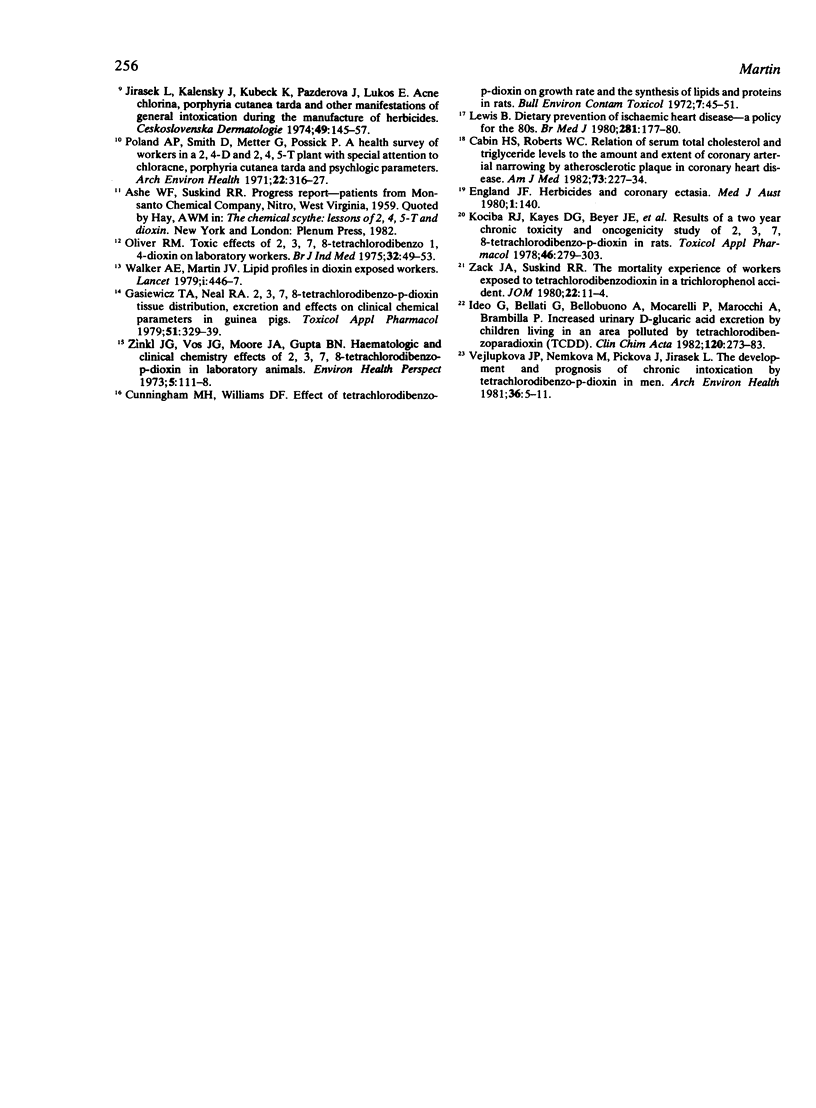Abstract
Ten years after an incident in which workers were exposed to tetrachlorodibenzodioxin (TCDD) a controlled biochemical study showed statistically significant increases in the serum cholesterol and triglyceride concentrations of workers both with and without chloracne. Urinary excretion of D-glucaric acid was significantly higher for all workers.
Full text
PDF


Selected References
These references are in PubMed. This may not be the complete list of references from this article.
- Cabin H. S., Roberts W. C. Relation of serum total cholesterol and triglyceride levels to the amount and extent of coronary arterial narrowing by atherosclerotic plaque in coronary heart disease. Quantitative analysis of 2,037 five mm segments of 160 major epicardial coronary arteries in 40 necropsy patients. Am J Med. 1982 Aug;73(2):227–234. doi: 10.1016/0002-9343(82)90183-8. [DOI] [PubMed] [Google Scholar]
- Cunningham H. M., Williams D. T. Effect of tetrachlorodibenzo-p-dioxin on growth rate and the synthesis of lipids and proteins in rats. Bull Environ Contam Toxicol. 1972 Jan;7(1):45–51. doi: 10.1007/BF01709175. [DOI] [PubMed] [Google Scholar]
- DUGOIS P., COLOMB L. Remarques sur l'acné chlorique; à propos d'une éclosion de cas provoqués par la préparation du 2-4-5-trichlorophénol. J Med Lyon. 1957 Oct 20;38(907):899–903. [PubMed] [Google Scholar]
- England J. F. Herbicides and coronary ectasia. Med J Aust. 1981 Feb 7;1(3):140–140. doi: 10.5694/j.1326-5377.1981.tb135392.x. [DOI] [PubMed] [Google Scholar]
- Gasiewicz T. A., Neal R. A. 2,3,7,8-Tetrachlorodibenzo-p-dioxin tissue distribution, excretion, and effects on clinical chemical parameters in guinea pigs. Toxicol Appl Pharmacol. 1979 Nov;51(2):329–339. doi: 10.1016/0041-008x(79)90475-7. [DOI] [PubMed] [Google Scholar]
- Ideo G., Bellati G., Bellobuono A., Mocarelli P., Marocchi A., Brambilla P. Increased urinary D-glucaric acid excretion by children living in an area polluted with tetrachlorodibenzoparadioxin (TCDD). Clin Chim Acta. 1982 Apr 23;120(3):273–283. doi: 10.1016/0009-8981(82)90368-0. [DOI] [PubMed] [Google Scholar]
- Jirásek L., Kalenský J., Kubec K., Pazderová J., Lukás E. Acne chlorina, porphyria cutanea tarda a jiné projevy celkové intoxikace pri výrobe herbidic. II. Cesk Dermatol. 1974 Jun;49(3):145–157. [PubMed] [Google Scholar]
- Kociba R. J., Keyes D. G., Beyer J. E., Carreon R. M., Wade C. E., Dittenber D. A., Kalnins R. P., Frauson L. E., Park C. N., Barnard S. D. Results of a two-year chronic toxicity and oncogenicity study of 2,3,7,8-tetrachlorodibenzo-p-dioxin in rats. Toxicol Appl Pharmacol. 1978 Nov;46(2):279–303. doi: 10.1016/0041-008x(78)90075-3. [DOI] [PubMed] [Google Scholar]
- Lewis B. Dietary prevention of ischaemic heart disease--a policy for the '80s. Br Med J. 1980 Jul 19;281(6234):177–180. doi: 10.1136/bmj.281.6234.177. [DOI] [PMC free article] [PubMed] [Google Scholar]
- May G. Tetrachlorodibenzodioxin: a survey of subjects ten years after exposure. Br J Ind Med. 1982 May;39(2):128–135. doi: 10.1136/oem.39.2.128. [DOI] [PMC free article] [PubMed] [Google Scholar]
- Oliver R. M. Toxic effects of 2,3,7,8 tetrachlorodibenzo 1,4 dioxin in laboratory workers. Br J Ind Med. 1975 Feb;32(1):49–53. doi: 10.1136/oem.32.1.49. [DOI] [PMC free article] [PubMed] [Google Scholar]
- Pazderova-Vejlupková J., Lukás E., Nemcova M., Pícková J., Jirásek L. The development and prognosis of chronic intoxication by tetrachlordibenzo-p-dioxin in men. Arch Environ Health. 1981 Jan-Feb;36(1):5–11. doi: 10.1080/00039896.1981.10667598. [DOI] [PubMed] [Google Scholar]
- Poland A. P., Smith D., Metter G., Possick P. A health survey of workers in a 2,4-D and 2,4,5-T plan with special attention to chloracne, porphyria cutanea tarda, and psychologic parameters. Arch Environ Health. 1971 Mar;22(3):316–327. doi: 10.1080/00039896.1971.10665850. [DOI] [PubMed] [Google Scholar]
- Poland A., Glover E. An estimate of the maximum in vivo covalent binding of 2,3,7,8-tetrachlorodibenzo-p-dioxin to rat liver protein, ribosomal RNA, and DNA. Cancer Res. 1979 Sep;39(9):3341–3344. [PubMed] [Google Scholar]
- Scarisbrick D. A., Martin J. V. Biochemical changes associated with chloracne in workers exposed to tetrachlorazobenzene and tetrachlorazoxybenzene. J Soc Occup Med. 1981 Oct;31(4):158–163. doi: 10.1093/occmed/31.4.158. [DOI] [PubMed] [Google Scholar]
- Walker A. E., Martin J. V. Lipid profiles in dioxin-exposed workers. Lancet. 1979 Feb 24;1(8113):446–447. doi: 10.1016/s0140-6736(79)90929-2. [DOI] [PubMed] [Google Scholar]
- Zack J. A., Suskind R. R. The mortality experience of workers exposed to tetrachlorodibenzodioxin in a trichlorophenol process accident. J Occup Med. 1980 Jan;22(1):11–14. [PubMed] [Google Scholar]
- Zinkl J. G., Vos J. G., Moore J. A., Gupta B. N. Hematologic and clinical chemistry effects of 2,3,7,8-tetrachlorodibenzo-p-dioxin in laboratory animals. Environ Health Perspect. 1973 Sep;5:111–118. doi: 10.1289/ehp.7305111. [DOI] [PMC free article] [PubMed] [Google Scholar]


